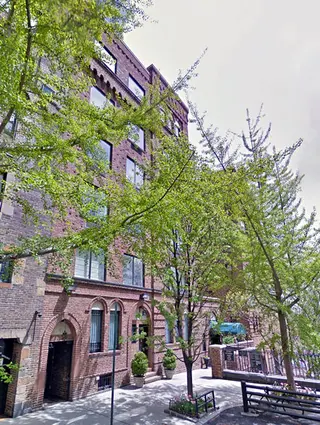 Carter Horsley
Carter HorsleyDec 08, 2017
Carter's Review
This attractive, 6-story, red-brick apartment building at 455 East 51st Street anchors the northern end of Beekman Place and was erected in 1925 by Joseph B. Thomas, who had in 1910 developed the “Block Beautiful” on 19th Street between Irving Place and Third Avenue where, according to a June 28, 1998 “Streetscapes” column in The New York Times, he had transformed “the declining brownstones with bright stucco and romantic ironwork.”
The east side of this H-shaped building faces the East River and the south side overlooks an attractive, sunken park and Beekman Place’s townhouses.
The building, which was designed by Treanor & Fatio, has 37 co-operative apartments.
It is known as Beekman Terrace.
Bottom Line
A very prime Beekman Place location with many wonderful views, wood-burning fireplaces, and an impressive, landscaped courtyard.
Description
A red-brick building at the cul-de-sac northern end to Beekman Place with a canopied entrance across from the staircase down to a sunken park, an arched and rusticated ground floor, and a quite grand, landscaped courtyard.
The building has some protruding air-conditioners.
According to Mr. Gray’s 1998 article, the building was “the first luxury apartment house to discover the neglected East River waterfront.” He noted that Mr. Thomas, its developer, had been born in Boston, where he had “admired Fenway Court, the Venetian-style building in his hometown that is now the Isabella Stewart Gardner Museum.” The 1924 design for the site was a building of “Venetian design overlooking the water” that was subsequently revised a bit to have “an open lawn bounded by an urn-topped balustrade leading to a Venetian-style dock,” adding that “there was also an upper garden area.”
“The irregular brick façade is decorated with terra cotta plaques showing the lion, the symbol of Venice's patron, St. Mark, and maritime symbols recalling Venice's days as a trading empire. Continuing the Venetian conceit, Thomas's wife, the muralist Clara Fargo Thomas, wrote that New Yorkers were ‘only just beginning to realize what our waterfronts might mean to us….'
“Original drawings for the building do not call out any unusual uses for the two floors below the grade of 51st Street, but an illustration published in Arts & Decoration in 1924 shows a large Gothic-style, leaded glass window at the level of the river, as if leading to some sort of club room.
“The East River Drive wiped out all the interesting wrinkles of the waterfront in the 1940's and photographs at the time show the lower garden area as a simple grassy area surrounded by a perimeter of hedges. But the constantly increasing traffic on the Drive has left the lower garden about as peaceful as the median on the Grand Central Parkway.”
Amenities
The building has a very nice roof deck, an attended lobby, a very handsome, landscaped courtyard and impressive vistas of the East River and Beekman Place. It permits pets and has storage.
Apartments
Apartment 2F is a three-bedroom unit with a 9-foot-wide entry foyer next to a 9-foot-wide, open kitchen off the 15-foot-wide dining room that opens off the 20-foot-long living with a fireplace and a 13-foot-long terrace.
Apartment 6A is a two-bedroom unit with a 23-foot-long entrance gallery that leads to a 22-foot-wide living room and a 16-foot-wide dining room next to a 21-foot-long kitchen. The unit also has a 14-foot-long study.
Apartment 6F is a three-bedroom unit with an entry foyer next to a 10-foot-wide enclosed and windowed kitchen that leads to a 15-foot-wide dining room and a 20-foot-long living room with a fireplace.
Apartment 2D is a two-bedroom unit with an entry foyer that leads to a 21-foot-long living room with a fireplace and a 10-foot-wide, windowed kitchen. The apartment had been owned by Arthur B. Schlesinger, the historian.
Another two-bedroom unit has a 10-foot-wide, windowed kitchen with a breakfast bar that leads to a 34-foot-wide living room with a wood-burning fireplace.
A one-bedroom unit has a 19-foot-long entrance gallery that leads to a 7-foot-wide foyer next to an 8-foot-long kitchen that leads to a 20-foot-long living room with a wood-burning fireplace, a 7-foot-wide dining room and a 12-foot-wide library.
History
A January 13, 1985 article by Dee Wedemeyer in The New York Times noted that “the board of directors of a cooperative apartment house at 455 East 51st Street has notified shareholders that negotiations have terminated with a prospective buyer who had offered $43 million for the property.’
“If the deal had gone through,” the article continued, “it would have been one of the rare cases in which the cooperative owners of a building had agreed to be bought out and probably would have achieved a record price for a residential site. The prospective sale of the property, known as Beekman Terrace, also led to community opposition to a new high-rise building on the site and to high-rises in the adjacent area.”
The article stated that under existing zoning a new building could contain about three times are much space as the existing one.
An August 24, 1986 article in The New York Times by Michael Freitag noted that among the famous people who lived on Beekman Place were John D. Rockefeller 3d, Irving Berlin, Gloria Vanderbilt, Rex Harrison and Princess Ashraf Pahlavi, the twin sister of the last Shah of Iran.”
“In 1985,” the article continued, “the buyout efforts at Beekman Terrace and other rumors of impending development caused some residents to request a change in the neighborhood's zoning. ‘'We are interested in maintaining the quiet and gracious environment in the area,’ said Letty H. Simon, executive director of the Riverfront Fifties Association, which led the downzoning effort. Although the proposal received some opposition, the Board of Estimate agreed last July to reduce the zoning of the Beekman Place area from R-10, the city's highest residential density, to R-8b, which greatly limits the size of new buildings.”
“Beekman Place is named for a descendant of William Beekman, one of the early Dutch settlers in New York. Several generations of Beekmans lived in a mansion near the intersection of 51st Street and First Avenue. The house, known as 'Mount Pleasant,' served as a British military headquarters during the American Revolution….In the 1800's, the Beekman Place area was considered a prestigious address, but by the turn of the century the neighborhood had been taken over by the impoverished immigrants who had flocked to the East Side seeking work at the local slaughterhouses. Beekman Place regained its exclusivity in the 1920's, when Alfred Lunt and Lynne Fontanne, Elisabeth Marbury, Anne Morgan and Anne Harriman (Mrs. William K. Vanderbilt) moved there and into nearby Sutton Place.”

- Co-op built in 1924
- 2 apartments currently for sale ($695K to $1.8M)
- Located in Beekman/Sutton Place
- 37 total apartments 37 total apartments
- 10 recent sales ($500K to $2.5M)
- Doorman







 6sqft delivers the latest on real estate, architecture, and design, straight from New York City.
6sqft delivers the latest on real estate, architecture, and design, straight from New York City.
